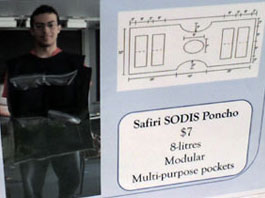Not all inventions need to be grandiose, complex things, Amy Smith said at TED2006: sometimes they can be simple and smart ideas that just help a lot of people (watch her speech – read summary). That’s the philosophy behind her first International Development Design Summit (IDDS), which just took place at MIT, where she teaches and heads the D-Lab (understand the "D" as placeholder for both Design and Development).
The IDDS is not a conference. It’s a monthlong collaborative learning program, as Jonathan Greenblatt describes in a nice wrap-up he wrote for WorldChanging:
People from locales as disparate as Brazil, Ghana, Haiti, Pakistan, and Tibet converged on MIT for the program: a month of intensive collaboration and learning. Participants self-organized into teams and were paired with mentors from top-notch design firms such as Continuum and IDEO. IDDS’s rich classroom experience involved case studies and lectures taught by MIT faculty, as well as development experts (…) IDDS put forth incredibly basic design criteria. Teams were required to create innovations to serve a clear development need, to use locally available materials and to do so at a low cost.
The end products offer fresh takes on old problems, including an off-grid refrigeration unit tailored for rural areas, a low-cost greenhouse from recycled materials, and microbial power sources (a list of all the IDDS projects is available here).
Greenblatt offers more details on a specific product designed to enable
efficient and hygienic water transport:
Typically, women and children in rural
settings often can journey up to six miles daily to retrieve water for
their families.
They frequently return to their homes carrying between
20 to 40 pounds on their backs or heads in unsound, unwieldy and often unclean vessels such as petroleum cans or ceramic pots. It’s a
ritualized behavior that sustains the cycle of disease, reduces human
productivity and creates tremendous physical strain. An IDDS team created a striking device, SODIS Safiri, to deal with
these challenges. (…) Water is carried in ergonomic, low-cost plastic pouches that
can be worn like apparel. Imagine a "backpack" that can be manufactured
for five dollars and efficiently bear up to four liters, or a poncho
that can carry twice that amount at a cost of only seven dollars. Along with improving transport efficiency, the SODIS Safiri device
capitalizes on the otherwise non-productive return journey: the
transparent design facilitates solar disinfection (SODIS) of the water so that
the water can be consumed upon arrival at the village. While some
contaminants cannot be handled solely by ultraviolet rays, this
zero-cost approach could be sufficient in many non-industrial locations
where basic microbial contamination creates diseases.
Brilliant. Simple. Relevant. I can imagine Amy Smith smiling in the back of the room while the students presented this idea.
